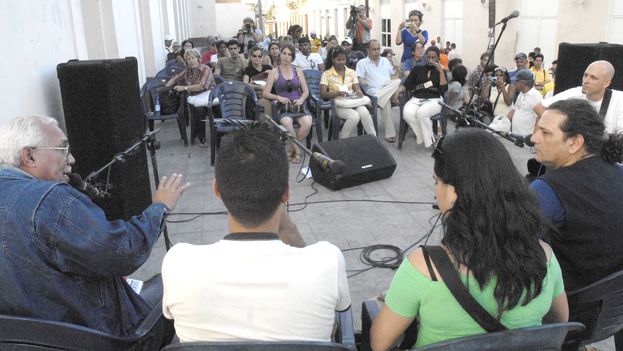
![]() 14ymedio, Jose Gabriel Barrenechea, Santa Clara, 5 September 2016 – A certain letter from Aristides Vega Chapu to the weekly Vanguardia, already quite old and that I believe I came into my hands in the middle of last July, set off a media frenzy last week. Knowing, as I do, that there is a lot going on beneath the apparent tranquility of Santa Clara’s intellectual media, my first reaction was surprise at the extraordinary resonance of this document in particular, as there had been previously with the similar reception of another in its time, from the young people of Vanguardia’s base committee of the Young Communists Union (UJC).
14ymedio, Jose Gabriel Barrenechea, Santa Clara, 5 September 2016 – A certain letter from Aristides Vega Chapu to the weekly Vanguardia, already quite old and that I believe I came into my hands in the middle of last July, set off a media frenzy last week. Knowing, as I do, that there is a lot going on beneath the apparent tranquility of Santa Clara’s intellectual media, my first reaction was surprise at the extraordinary resonance of this document in particular, as there had been previously with the similar reception of another in its time, from the young people of Vanguardia’s base committee of the Young Communists Union (UJC).
So I said to Aristides this Saturday, while trying to convince him to be interviewed by the newspaper, which he politely declined: “Gabriel, I already said what I had to say and where I had to say it,” was his response, and I understood, because he really did and has always been a powerhouse of the national culture.
This is not Aristides’ first letter, nor has he only denounced censorship in his letters. Not is it the first movement of intellectual concern from here. Not to mention that in the now distant nineteen-nineties, there emerged more than a few groups of challengers and even open opposition in the world of pilonga* letters.
The first movement I remember in those times of raulato was that led by a group of young authors back in 209: they demanded a less crazy tax framework, having suffered the anger of certain cultural officials, they managed to collect a number of important signatures in support of their petition. One of the most outstanding figures of this movement that soon transcended the limits of Villa Clara was the narrator Anisley Negrín, the best graduate of my course in the Onelio Literature Center, and winner of the 2008 David Prize**, someone who has apparently left our city, in the current move of the best of our writers to the United States.
Ultimately, the question is that some seem to have suddenly discovered this little corner “of the interior,” and avidly launch themselves on the first scandal they come across, with which they create the false impression that it is now Santa Clara that is moving. Thus they forget, in my mind, two complaint letters from Otilio Carvajal, one from Perez de Castro, another famous one from Aristides himself, denouncing the badly handled finances of certain cultural organizations here, and one from Pedro Llanes in which he complains about the discrimination against certain of his friends on the guest lists of the Provincial Book Fairs.
Nor do they take into account two posts demanding profound changes in the Cuban State that Ernesto Peña published on my blog, El Hidalgo Rural Cubano (The Rural Cuban Gentleman), and that as a result of the harassment he was then subjected to by the “compañeros” of State Security, he had a nervous breakdown. Or in the semblance of insignificant arm wrestling that, under the name of the baseball team from here, Lorenzo Lunar and Feliz Julio Alfonso have maintained for the last two years with none other than the province’s first secretary, in the egregious ears of whom a gray sportscaster and snitch with political police license plates never tires of dispensing accusations against those two as “restorationists” – that is supporters of capitalism.
That the literature in this city is in a keen state of restlessness is demonstrated by Otro Lunes (Another Monday) or Árbol Invertido (Inverted Tree), the two most serious Cuban cultural magazines edited from the opposition camp. What other city in the country, including Havana, has provided a similar number of collaborators? In what other city, besides the Havana of Voices, have the intellectuals dared to collaborate massively with a magazine with as few antecedents as Cuadernos de Pensamiento Plural (Notebooks of Plural Thinking)?
As for Vanguardia, the June issue is not the first clash in the last three years. In Ranchuelo Yandrey Lay Fabregat is now dedicated to narrative, and is perhaps one of the best cultural chroniclers of this region, to whom they have made it very difficult in Vanguardia, with the usual censorship in the country compounded by the abysmal mediocrity of those who lead or have led it in recent years.
In Santa Clara those who dedicate themselves to literature have worked in silence for a long time, without so much adherence to the tremendismos***. If you are not aware of this it is because you never had the opportunity to attend some of Aristides’ gatherings, especially the so-called “The Moment of Truth,” where more devastating truths than those of his letter of long ago have been heard.
Translator’s notes:
*Pilongo/a is a term used to refer to someone from Santa Clara, Cuba. It is a reference to those baptized in the huge baptismal font – called a “pilón,” hence “pilongo” – opposite the Cathedral which was demolished in the 1920s.
**The David Prize, awarded by the Artists and Writers Union (UNEAC), is one of the most important literary awards in Cuba (see Wikipedia).
***Tremendismo is a literary narrative technique developed in the Spanish novel in the 1940s which features violence, sordidness and direct, hard language (see Wikipedia).
